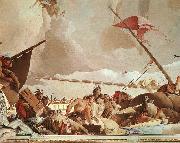Wholesale Oil Painting No Minimum |
|||||||||||
|
|
|||||||||||

|
|||||||||||
|
|
|
||||||||
Giovanni Battista TiepoloItalian Rococo Era Painter, 1696-1770 Giovanni Battista Tiepolo was born in Venice on March 5, 1696. His father, who was part owner of a ship, died when Tiepolo was scarcely a year old, but the family was left in comfortable circumstances. As a youth, he was apprenticed to Gregorio Lazzarini, a mediocre but fashionable painter known for his elaborately theatrical, rather grandiose compositions. Tiepolo soon evolved a more spirited style of his own. By the time he was 20, he had exhibited his work independently, and won plaudits, at an exhibition held at the church of S. Rocco. The next year he became a member of the Fraglia, or painters guild. In 1719 he married Cecilia Guardi, whose brother Francesco was to become famous as a painter of the Venetian scene. They had nine children, among them Giovanni Domenico and Lorenzo Baldassare, who were also painters. In the 1720s Tiepolo carried out many large-scale commissions on the northern Italian mainland. Of these the most important is the cycle of Old Testament scenes done for the patriarch of Aquileia, Daniele Dolfin, in the new Archbishop Palace at Udine. Here Tiepolo abandoned the dark hues that had characterized his early style and turned instead to the bright, sparkling colors that were to make him famous. |
||||||||
|
|
||||||||
Glory of Spain
Glory of Spain Painting ID:: 63772 |
1762-66 Fresco, 2700 x 1000 cm Throne Room, Palacio Real, Madrid The loading of a European ship with the treasures of the American continent is depicted in a direct allusion to the discovery of America by Christopher Columbus and to the Spanish conquest of the New World in the l6th century. The two Red Indians in the foreground, who throw themselves to the ground in front of the ship, symbolize the Europeans' victory over the natives.Artist:TIEPOLO, Giovanni Battista Title: Glory of Spain (detail) Painted in 1701-1750 , Italian - - painting : mythological 1762-66 Fresco, 2700 x 1000 cm Throne Room, Palacio Real, Madrid The loading of a European ship with the treasures of the American continent is depicted in a direct allusion to the discovery of America by Christopher Columbus and to the Spanish conquest of the New World in the l6th century. The two Red Indians in the foreground, who throw themselves to the ground in front of the ship, symbolize the Europeans' victory over the natives.Artist:TIEPOLO, Giovanni Battista Title: Glory of Spain (detail) Painted in 1701-1750 , Italian - - painting : mythological |
|||||||
|
|
||||||||
|
Giovanni Battista Tiepolo Italian Rococo Era Painter, 1696-1770 Giovanni Battista Tiepolo was born in Venice on March 5, 1696. His father, who was part owner of a ship, died when Tiepolo was scarcely a year old, but the family was left in comfortable circumstances. As a youth, he was apprenticed to Gregorio Lazzarini, a mediocre but fashionable painter known for his elaborately theatrical, rather grandiose compositions. Tiepolo soon evolved a more spirited style of his own. By the time he was 20, he had exhibited his work independently, and won plaudits, at an exhibition held at the church of S. Rocco. The next year he became a member of the Fraglia, or painters guild. In 1719 he married Cecilia Guardi, whose brother Francesco was to become famous as a painter of the Venetian scene. They had nine children, among them Giovanni Domenico and Lorenzo Baldassare, who were also painters. In the 1720s Tiepolo carried out many large-scale commissions on the northern Italian mainland. Of these the most important is the cycle of Old Testament scenes done for the patriarch of Aquileia, Daniele Dolfin, in the new Archbishop Palace at Udine. Here Tiepolo abandoned the dark hues that had characterized his early style and turned instead to the bright, sparkling colors that were to make him famous. Glory of Spain 1762-66 Fresco, 2700 x 1000 cm Throne Room, Palacio Real, Madrid The sea-goddess Thetis hovers on a cloud, together with her spouse Oceanus, and holds aloft a shell filled with treasures. Tritons and Nereids, who are meant to symbolize the riches of the sea, accompany the scene. The attempt to bridge the austere Classical golden frame using the group of figures and the orange tree at the lower edge of the picture (possibly a personification of the Province of Aragon), and to create the typical connection between the fresco and the space occupied by the viewer does not succeed here.Artist:TIEPOLO, Giovanni Battista Title: Glory of Spain (detail) Painted in 1701-1750 , Italian - - painting : mythological |
||||||||
|
|
||||||||
|
Prev Next
|
||||||||
|
|
||||||||
|
Related Paintings to Giovanni Battista Tiepolo :. |
||||||||
|
|
||||||||
|
CONTACT US |

